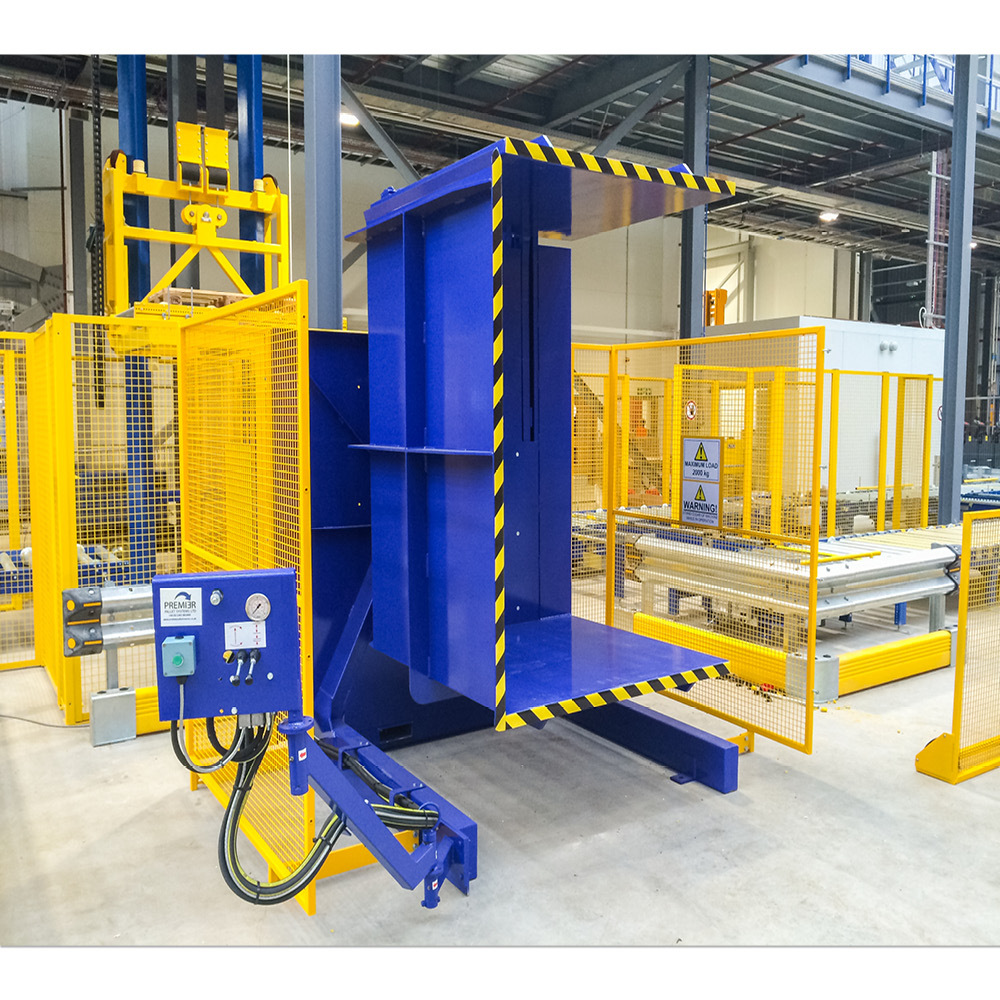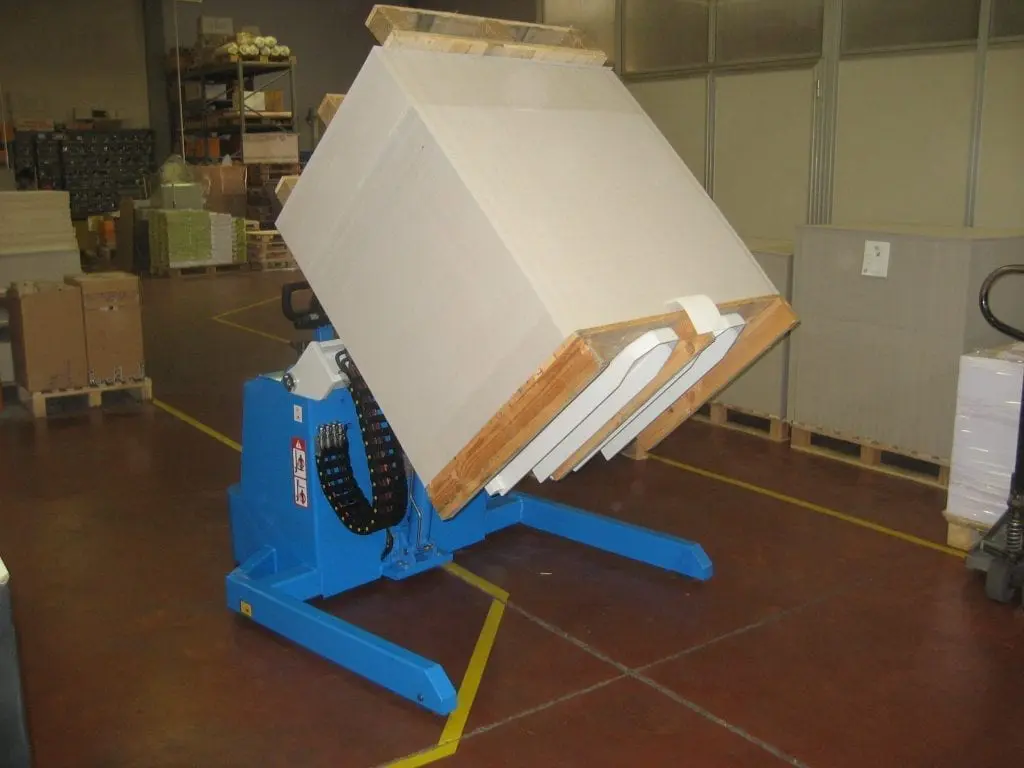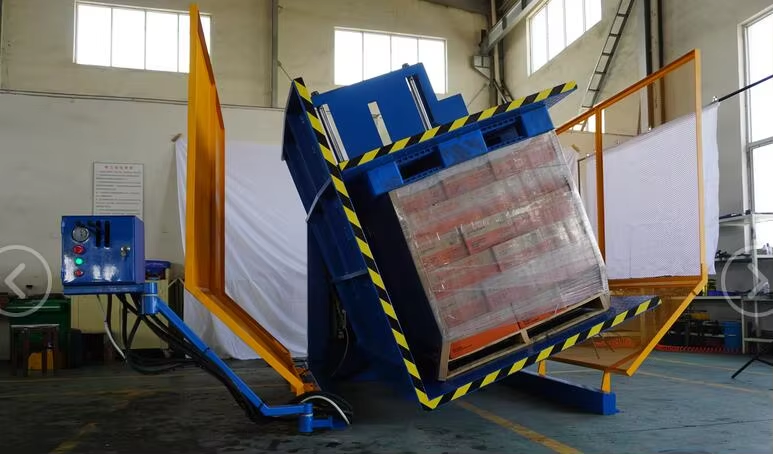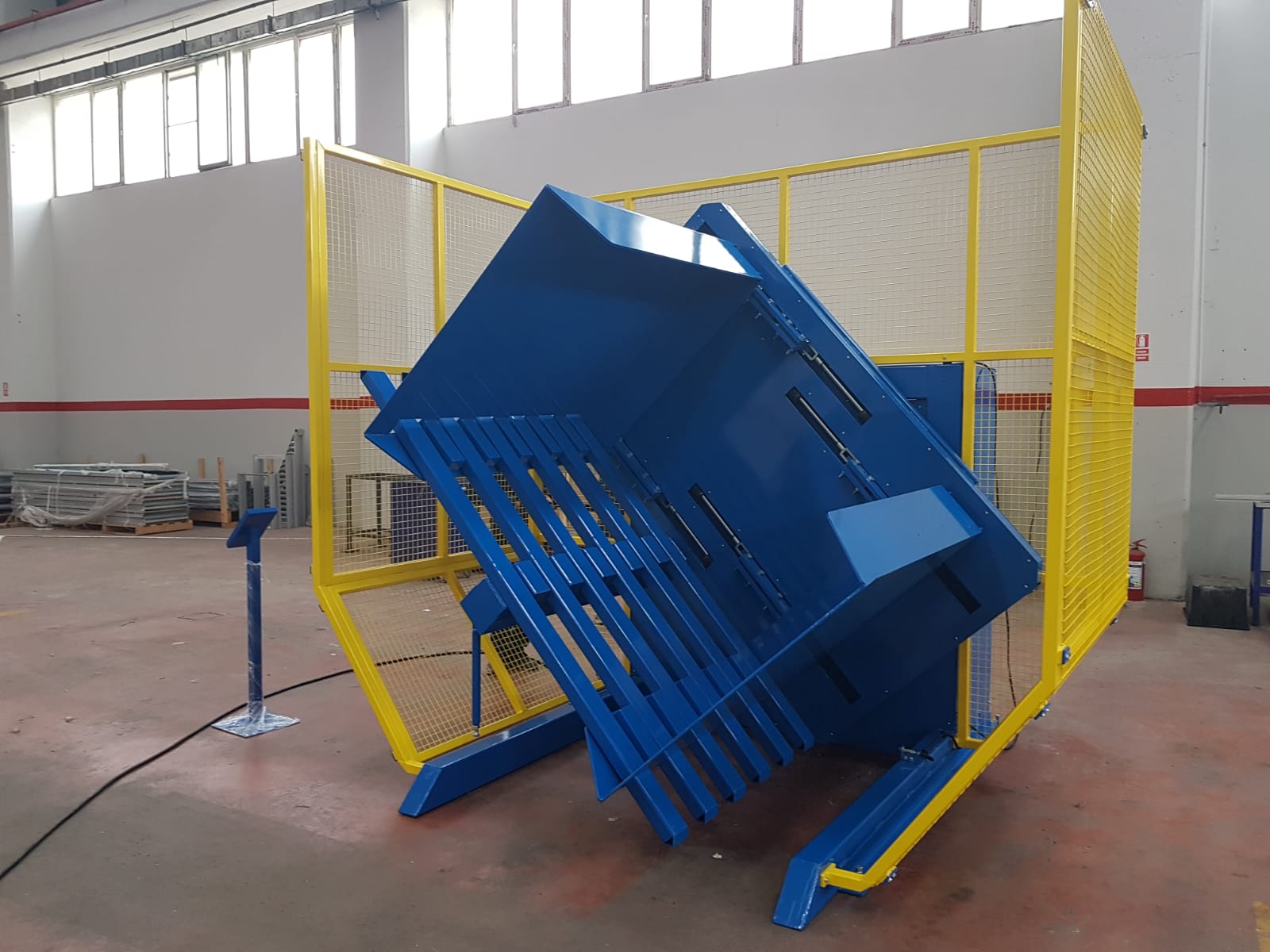Choosing the Right Pallet Inverter for Europe's Demands in Multi-Standard Adaptability Across EU Warehouses
Your warehouse is the heart of your European logistics. But you have a problem. You receive goods on one type of pallet, maybe a standard EUR-pallet, but your customer or your next process requires a different one, like a UK-standard or a plastic hygienic pallet. This constant need to switch loads is a logistical nightmare. It creates bottlenecks, requires manual labor that is slow and risky, and can even lead to damaged goods. Every minute spent manually re-stacking a pallet is a minute lost in productivity, and it eats away at your profit margins. You need a solution that is fast, safe, and flexible enough to handle the diverse demands of the European market.
The right pallet inverter for Europe's multi-standard warehouses is a highly adjustable, automated machine designed for flexibility and compliance. It must seamlessly handle various pallet sizes, such as the 800x1200mm EUR1, the 1000x1200mm EUR2, and the 1200x1000mm UK standard pallet, often without needing manual tool changes. Key features to look for include a wide clamping range, adjustable pressure settings for delicate loads, and full compliance with European safety standards, including the CE Machinery Directive 2006/42/EC.

I've spent over two decades in this industry, from working on the factory floor to building my own company, SHJLPACK. I’ve seen firsthand how a small piece of equipment can make or break an entire operation. A pallet inverter isn't just a machine; it's a critical tool for efficiency. Making the wrong choice can lead to years of frustration. But getting it right can unlock new levels of productivity. Let’s dive deeper into the specific questions you should be asking. This will help you choose a machine that not only solves today's problems but also supports your growth for years to come.
How can a pallet inverter handle different EU pallet sizes like EUR, UK, and CHEP?
You have a load of product that just arrived on a wooden CHEP pallet. But your internal process requires it to be on a hygienic plastic pallet. Or maybe your shipment to the UK needs to be on a UK-standard pallet, not the EUR-pallet it's currently on. This constant mismatch creates a serious bottleneck. You might have workers manually unstacking and restacking goods, which is slow, physically demanding, and a recipe for product damage or worker injury. You need a single machine that can handle this variety without fuss. But how can one piece of equipment adapt so easily?
A modern pallet inverter handles different EU pallet sizes through highly engineered adjustable clamping platforms and a robust rotation mechanism. The key is its ability to adjust both the width and the clamping pressure. For example, it can securely hold an 800mm wide EUR-pallet and, in the next cycle, adjust to grip a 1000mm wide UK-pallet. This is typically managed through a hydraulic or electric system controlled by a simple Human-Machine Interface (HMI). An operator can select a pre-programmed pallet size, and the machine adjusts automatically, ensuring a safe and secure transfer every time.

The Mechanics of Adaptability
The "magic" behind a versatile pallet inverter lies in its mechanical and control systems. There are two primary approaches to how the machine adjusts to different pallet dimensions: hydraulic and electric.
- Hydraulic Systems: These are the workhorses of the industry. They use fluid pressure to move the clamping platforms and provide immense, steady force. This makes them ideal for very heavy loads, like those we often see in the steel or building materials industries. The pressure can be finely tuned to be gentle enough for a pallet of bottled water or strong enough for a stack of metal components. I remember a client in the steel wire business who needed to handle coils that varied greatly in weight. A hydraulic system was the only choice that gave them both the power and the control they needed.
- Electric Systems: These use servo motors and screw actuators for movement. They offer incredible precision and are often faster for lighter loads. Electric systems are also cleaner, as there is no risk of hydraulic fluid leaks, which is a critical requirement in food, beverage, and pharmaceutical industries. They are also generally more energy-efficient and integrate very cleanly with modern digital control systems.
The choice between them depends entirely on your application, your load characteristics, and your factory environment.
Key Specifications for Multi-Pallet Handling
When you're looking at a spec sheet, don't just look at the maximum load capacity. You need to dig into the details of its dimensional adaptability. Here is a simple breakdown of common European pallet types and the machine specifications you need to consider.
| Pallet Type | Dimensions (W x L in mm) | Key Machine Requirement |
|---|---|---|
| EUR/EUR 1 | 800 x 1200 | Minimum clamping width must be less than 800mm. |
| EUR 2 | 1200 x 1000 | Clamping range must accommodate 1000mm and 1200mm. |
| EUR 3 | 1000 x 1200 | Same as EUR 2, requires wide clamping range. |
| UK Standard | 1200 x 1000 | Similar to EUR 2, a common standard for adaptability. |
| CHEP Pallet | Varies (e.g., 1200x1000) | Check for compatibility with block pallet design. |
| Half Pallet | 800 x 600 | Requires a very narrow minimum clamping width. |
The crucial specs are the Clamping Opening Range (the minimum and maximum width it can handle) and the Platform Size (it must be large enough to fully support your largest pallet). An inverter with a wide opening range, for instance from 550mm to 1300mm, offers incredible flexibility for both current and future needs.
What safety and compliance standards must a pallet inverter meet for the European market?
Imagine you've found a pallet inverter that looks perfect for your needs. The price is right, and the specs seem to match. But you have a nagging question: is it actually legal and safe to use in your European warehouse? The thought of installing a new machine only to have it shut down by safety inspectors is a manager's nightmare. Even worse is the risk of a serious accident involving one of your team members. Investing in non-compliant equipment isn't a saving; it's a massive liability waiting to happen. To protect your people and your business, understanding the required standards isn't just important—it's essential.
For any pallet inverter to be sold and operated in the European market, it must carry the CE marking. This marking is a declaration by the manufacturer that the machine complies with all relevant EU health, safety, and environmental protection legislation. The most important directive for this type of equipment is the Machinery Directive 2006/42/EC. This law outlines the essential health and safety requirements (EHSRs) that machinery must meet. Compliance is demonstrated through features like safety light curtains, perimeter fencing with interlocked gates, clearly marked emergency stop buttons, and a comprehensive risk assessment performed by the manufacturer.

Deconstructing the CE Mark
From my years of building machines, I can tell you that the CE mark is much more than just a sticker. It represents a promise of safety and quality backed by a rigorous process. A responsible manufacturer doesn't just "add" a CE mark at the end. They design the machine from the ground up with safety in mind. This process involves:
- Risk Assessment: Identifying every potential hazard associated with the machine during operation, maintenance, and cleaning. This includes mechanical risks (crushing, shearing), electrical risks, and ergonomic risks.
- Applying Harmonized Standards: Using specific technical standards (like EN ISO 13849 for safety-related parts of control systems) to eliminate or reduce the identified risks.
- Creating a Technical File: This is a comprehensive dossier containing all the evidence of compliance. It includes design drawings, electrical schematics, calculation notes, test results, and the risk assessment itself.
- Issuing a Declaration of Conformity: A legal document signed by the manufacturer stating that the machine meets all relevant directives.
When you are considering a supplier, ask to see their Declaration of Conformity. And more importantly, ask them about their risk assessment process. A good partner will be able to speak about it confidently.
Essential Safety Features Breakdown
Let's move from theory to the physical machine. When you inspect a pallet inverter, here are the non-negotiable safety features you should see, all of which are mandated by the Machinery Directive.
- Physical Guarding: This is typically a robust steel fence that creates an enclosed safety zone around the machine. It prevents anyone from accidentally walking into the machine's operational area while it's moving.
- Interlocked Access Gates: Any gate in the perimeter fence must have a safety interlock switch. If the gate is opened, the switch sends a signal to the control system to immediately stop all machine movement. The machine cannot be restarted until the gate is closed and a reset button is pushed.
- Light Curtains: These are photoelectric safety barriers placed at the loading and unloading points. If an operator's hand, a forklift, or any object breaks the light beam while the machine is in its cycle, it will instantly stop. This is a critical feature for preventing crushing injuries.
- Emergency Stops (E-Stops): These are prominent, easy-to-access red buttons. Pushing one will cut all power to the machine's motors and actuators, bringing it to a rapid and safe halt. They must be located at the main operator panel and other key points around the machine.
These features work together to create multiple layers of protection for your team.
How does a versatile pallet inverter improve operational efficiency and ROI?
Every business owner I know, including myself, looks at a new piece of equipment and asks the same fundamental question: "What is the return on this investment?" You have tight budgets and high expectations. A new machine has to do more than just perform a task; it needs to make your entire operation faster, cheaper, or better. If it doesn't positively impact your bottom line by tackling core inefficiencies, it's not an asset, it's just another expense on the books. So, how does a pallet inverter, specifically a versatile one, deliver a clear and rapid ROI?
A versatile pallet inverter improves operational efficiency and delivers a strong ROI by directly attacking three major cost centers: labor, product damage, and throughput. It transforms a slow, manual process into a quick, automated one. For instance, manually transferring a load from one pallet to another can take two workers 15-20 minutes. An inverter does the same job in under two minutes with a single operator. This reduction in labor cost is immediate and easy to measure. Furthermore, the secure, gentle handling of the machine virtually eliminates the product damage that is common with manual restacking, saving you money on lost inventory.

Calculating the ROI
Let's not talk in hypotheticals. I always encourage my clients to do the math. A basic ROI calculation can be very revealing. When I started my own factory, every yuan was precious, so I became very good at this kind of analysis. It helps you justify the investment to your partners or financial department.
Here’s a simplified model you can adapt:
| Cost Savings & Gains (Annual) | Example Calculation | Your Numbers |
|---|---|---|
| A. Labor Savings | (2 workers x €20/hr x 0.25 hr/pallet) - (1 worker x €20/hr x 0.03 hr/pallet) = €9.40/pallet. For 50 pallets/day, 250 days/yr = €117,500 | |
| B. Reduced Product Damage | 0.5% damage rate on loads worth €2000 x 50 pallets/day x 250 days/yr = €12,500 | |
| C. Increased Throughput | Faster truck turnaround, ability to process more orders. Harder to quantify, but let's be conservative: €10,000 | |
| Total Annual Gain (A+B+C) | €140,000 | |
| Investment (One-Time) | ||
| D. Machine & Installation Cost | -€70,000 | |
| E. Annual Maintenance | -€2,000 | |
| Year 1 Net Return | €68,000 |
This simple table shows that the machine can pay for itself in well under a year. This is the kind of practical analysis that a pragmatic owner like yourself, Mr. Morales, would appreciate. It moves the conversation from "cost" to "investment."
Beyond Labor Savings: Hidden Efficiencies
The big, obvious savings are in labor and product damage, but a good pallet inverter unlocks other efficiencies that are just as important.
- Improved Hygiene and Quality Control: In many industries, you cannot bring wooden pallets into clean production areas. An inverter allows you to switch to clean, in-house plastic or metal pallets at the receiving dock, preventing contamination.
- Enhanced Worker Safety: Manual handling of heavy loads leads to back injuries and other ergonomic problems. These result in lost workdays and higher insurance premiums. Automating this task makes the workplace safer, which has a real financial benefit and improves morale.
- Optimized Warehouse Space: Quickly consolidating loads or transferring to different sized pallets can help you better utilize your racking and floor space.
- Faster Dock-to-Stock Time: The faster you can process incoming goods, the faster they are available for production or for sale. A pallet inverter dramatically shortens this critical time.
I helped a client in the automotive parts sector who faced constant pressure from their downstream assembly line. By installing an inverter, they cut their receiving time for certain components by 75%. This not only saved them money but also made them a more reliable supplier, strengthening their relationship with their main customer.
What are the key maintenance and integration considerations for a modern, digitized warehouse?
You are building a smart factory. You're investing in MES platforms, IoT sensors, and data analytics to make your operations transparent and efficient. In this environment, a new machine cannot be a "dumb" island of steel. It must be a connected, intelligent part of your digital ecosystem. If it can't talk to your other systems, it creates a blind spot. This undermines your entire digitalization strategy and prevents you from achieving goals like predictive maintenance. Choosing a pallet inverter today means choosing one that is ready for the integrated, data-driven factory of tomorrow.
For a modern, digitized warehouse, the key integration consideration is the pallet inverter's ability to communicate with your central systems, like a WMS or MES. This is achieved through industrial communication protocols such as PROFINET, EtherNet/IP, or OPC-UA. The machine's PLC should be able to send status data (e.g., in cycle, idle, fault) and receive commands. For maintenance, look for machines built with IoT-ready sensors that can monitor motor vibration, hydraulic pressure, and cycle counts. This data is the foundation for a predictive maintenance program. Equally important is a design that allows for easy access to wear parts and a supplier who can offer remote diagnostics to minimize downtime.

The Path to Smart Integration
Integrating a pallet inverter into your digital backbone allows you to achieve true process visibility. This is a topic I am passionate about because it's where my engineering background meets the real-world needs of my clients.
- PLC and HMI: The machine's Programmable Logic Controller (PLC) is its brain. It should be from a reputable brand (like Siemens, Allen-Bradley, or Mitsubishi) for which you can easily find support. The Human-Machine Interface (HMI) should be intuitive, allowing operators to not only run the machine but also see diagnostic information.
- Communication Protocols: The inverter must speak the same language as your factory. Before you buy, confirm with the manufacturer that they can provide the machine with the correct communication card or gateway for your network. This enables the machine to report its cycle count, current status, and any error codes directly to your MES. Your production planners can then see in real-time if the receiving area is keeping up with demand.
- Data for Decision Making: Once the data is flowing, you can do powerful things. You can track the number of pallets processed per shift. You can correlate machine faults with specific load types. You can measure uptime and OEE (Overall Equipment Effectiveness) automatically. This is how you move from guessing to knowing.
Predictive vs. Preventive Maintenance
Your goal to increase equipment uptime to 95% is ambitious but achievable. It requires moving away from reactive or even standard preventive maintenance. Let's look at the difference in the context of a pallet inverter.
| Feature | Preventive Maintenance (Old Way) | Predictive Maintenance (New Way) |
|---|---|---|
| Strategy | Replace parts on a fixed schedule (e.g., every 2,000 hours). | Replace parts based on real-time condition data. |
| Triggers | Time or cycle count. | IoT sensor data (e.g., motor vibration exceeds threshold, hydraulic fluid temperature is too high). |
| Downtime | Planned, but may be unnecessary if parts are still good. | Minimized. Maintenance is done just before a failure occurs. |
| Cost | Higher, due to replacing perfectly good parts. | Lower, as you maximize the life of every component. |
| Example | "Change the hydraulic filter every 6 months." | "The pressure sensor shows the filter is 90% clogged. Schedule a change this weekend." |
To achieve predictive maintenance, the machine must be built with the right sensors. When you evaluate a pallet inverter, ask the manufacturer: "What sensors are standard? What can be added? How can I access that data?" A forward-thinking supplier will have clear answers.
This journey, from employee to factory owner, has taught me one crucial lesson: the best business relationships are partnerships. You are looking for a strategic partner, not just a vendor. A true partner doesn't disappear after the sale. They help with installation, they assist your team with integrating the machine into your control systems, and they are there to provide advice and support for years to come. This is the foundation on which I built SHJLPACK, and it's my promise to every client I work with.
Conclusion
Choosing the right pallet inverter is more than a purchase; it’s a strategic investment in efficiency, safety, and future-readiness for your European warehouse operations.





